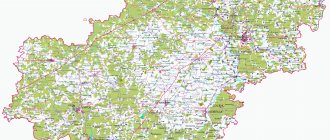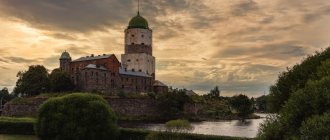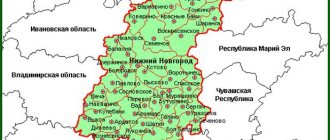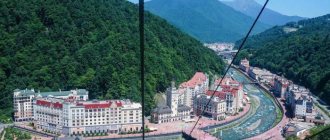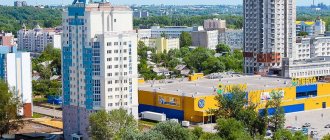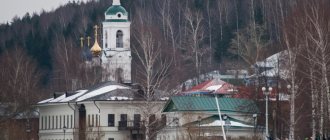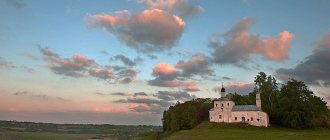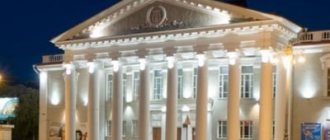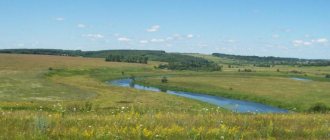The Moscow Region is located on the territory of the Central Federal District of the Russian Federation. If you look at a map of the Moscow region from a satellite, you can determine its location, consider the main natural, industrial and residential facilities, and get an idea of the region’s infrastructure.
The history of settlement on the site of the Moscow region goes back more than 20 thousand years. The flat lands, convenient for livestock farming and arable farming, attracted peasants, and the hills in the northern part made it possible to build fortified settlements.
About 300 large rivers (more than 10 km long) flow through the region. If you enlarge the map of the Moscow region by district, you can see rivers such as:
- Moscow;
- Klyazma;
- Oka;
- Lama;
- Protva;
- Sister;
- Dubna.
Several reservoirs are formed by river basins. The Moscow Canal passes through the region. It passes through several large reservoirs in the region. To view the canal, you can move with the mouse to the northern part of the map of the Moscow region by district.
More than 7 million people live in the region. The number of people living in the region is constantly increasing due to labor migration.
Content
- 1 Large cities 250-500 thousand people 1.1 Balashikha
- 1.2 Podolsk
- 2.1 Khimki
- 3.1 Reutov
- 4.1 Golitsyno
Yuri Petrovich Lyubimov
Lyubimov Yuri Petrovich [b.
September 17 (30), 1917, Yaroslavl], Russian theater director and actor, People's Artist of Russia (1992). USSR State Prize (1952). State Prize of the Russian Federation (1997). Born into a peasant family, in 1922 the family moved to Moscow. He entered the electromechanical technical school and at the same time studied in a choreographic studio. In 1933, at the age of 16, he entered the studio at the Moscow Art Theater-2, and during his studies he performed a cameo role in the play “A Prayer for Life” by J. Deval.
In 1939 he graduated from the Theater School. B.V. Shchukin at the Theater named after. E. B. Vakhtangov, as a student performed on the stage of this theater in the plays “Princess Turandot” and “Much Ado About Nothing.”
In 1941-47 served as entertainer in the NKVD song and dance ensemble. After demobilization he returned to the theater. Vakhtangov, where one of the first roles he played was the role of Benedict in the play “Much Ado About Nothing.” Among Lyubimov’s other works at that time: Cyrano in “Cyrano de Bergerac” by E. Rostand (1942), Oleg Koshevoy in “The Young Guard” based on the novel by A. Fadeev (1947), Chris in the play “All My Sons” by A. Miller ( 1948), Shubin in “On the Eve” based on the novel by I. S. Turgenev (1948), Izvekov in “Kirill Izvekov” based on the novel “First Joys” by K. A. Fedin (1951). In 1953, for the role of Tyatin in the play “Yegor Bulychev” based on the play by A. M. Gorky (1952), he was awarded the USSR State Prize.
Since 1953 he became a teacher at the school. Shchukin. In 1959, he first tried himself as a director, staging the play “How Much Does a Man Need” based on the play by A. Galich.
In 1963, with the help of a course of students that he taught, he staged the graduation performance “The Good Man from Szechwan” by B. Brecht. The performance was a huge success. On the basis of this performance, a new theater was opened in 1964 - the Taganka Drama and Comedy Theater, which was headed by Lyubimov as chief director. In the 1960-1970s. this theater played a significant role in shaping public opinion in an atmosphere of stagnation. Lyubimov created a special journalistic theater, which, in the atmosphere of Soviet censorship, raised the most pressing issues of our time. Almost every one of his performances made it onto the stage with great difficulty, and some were banned by the authorities. The talented director managed to create a unique acting group of like-minded people, where there were no obvious “first violins”, but there was a single, powerful ensemble that always played in unison under the direction of only its conductor, Lyubimov. Among his best productions: “Ten Days That Shook the World” by J. Reed (1965), “Listen!” by V.V. Mayakovsky (1967), “Pugachev” by S.A. Yesenin (1967), “Tartuffe” by Moliere (1968), “Alive” by B.A. Mozhaev (1968, banned, resumed in 1989), “Mother” by A. M. Gorky (1969), “Hamlet” by W. Shakespeare (1971), “And the dawns here are quiet...” by B. L. Vasiliev (1971), “The Master and Margarita” by M. A. Bulgakov (1977), “House on the Embankment” after Yu. V. Trifonov (1980), “Boris Godunov” by A. S. Pushkin (1982). In 1976, at the international festival BITEF, the play “Hamlet” received the Grand Prix.
In 1984, Lyubimov, who was abroad, was first released from the post of chief director, and then deprived of USSR citizenship. In 1984-89, he staged performances on the most prestigious stages in Europe (he began to be invited to foreign productions in 1975). In 1989, due to the perestroika process, his citizenship was restored. Arriving in the USSR, he staged the plays “A Feast in the Time of Plague” (based on “Little Tragedies” by A. S. Pushkin, 1989) and “Suicide” by N. Erdman (1990).
In 1991 he returned to Russia. In 1992 he proposed a new model of theater work, in which there was no place for many of the actors of the former Taganka. There was a split in the theater, and at the same time a separate group, the “Commonwealth of Taganka,” arose.
Lyubimov, despite this turn, continued to work. He staged “Zhivago (Doctor)” based on B. L. Pasternak (1993), “Teenager” (1996) and “The Brothers Karamazov” (1997) based on F. M. Dostoevsky, “Sharashka” based on A. I. Solzhenitsyn (1998 ), “Chronicles” based on the tragedies of W. Shakespeare (2000), “Eugene Onegin” based on the novel by A. S. Pushkin (2000), “Theatrical novel” based on M. A. Bulgakov (2001), “Socrates” (2001), “Faust” after Goethe (2002), “Go and stop (Oberiuts)” (2004).
At the same time, the director continued to work abroad in theaters in Finland, Greece, Germany, etc.
He starred in the films “Restless Farming” (1946), “Kuban Cossacks” (1950), “Three Meetings” (1950), “Man from Planet Earth” (1959), “Cain the Eighteenth” (1963), “A Farm in the Steppe” (1970) and others.
Large cities 250-500 thousand people
Coat of arms of Balashikha
Balashikha
Population 428,400 people (2016).
Founded in 1830, city since 1939. In fact, being one of the suburbs of Moscow, the city grew sharply in 2015 due to the annexation of the neighboring city of Zheleznodorozhny. Formerly a center of light industry, it is now a center of mechanical engineering.
Coat of arms of Podolsk
Podolsk
Population 293,765 people (2016).
Founded in 1559, city since 1781. It grew noticeably in 2015 due to the annexation of the city of Klimovsk. Center for the mechanical engineering industry, especially in the field of heat exchange equipment, primarily for nuclear energy.
Kolomna is a scientific center of the Moscow region
At the place where the Oka and Moskva rivers merge stands the ancient Kolomna. The appearance perfectly and harmoniously combines patriarchal and modern features. Kolomna deserves to be included in the Golden Ring of Russia, but due to its location it did not get into it. On lands with an area of only 65.10, 420 monuments are stored; tourists come here to admire ancient churches, monasteries, and Cathedral Square. In ancient times, Kolomna suffered from severe fires and epidemics that claimed many lives. There was even a place of honorable exile here.
It even has its own Kremlin, built in 1525-1531, after the construction of which the strategic importance of the town increased. The stone walls of the Kremlin are complemented by towers that are built into the wall in case of its destruction. After the installation of such a structure, the enemies were never able to take the Kremlin.
Today, modern Kolomna is one of the largest scientific and industrial centers in the Moscow region. The most important industrial enterprises operate here, there is a confectionery factory, a meat processing plant, and a printing house. Local institutes and universities provide young people with a good education.
Large cities 100-250 thousand people
Coat of arms of Khimki
Khimki
Population 239,967 people (2016).
Coat of arms of Korolev
Korolev
Population 224,348 (2019). Founded in 1938, until 1996 it was called Kaliningrad. It also includes the science city Yubileiny - in 2014 it was united into an administrative-territorial unit of the Moscow region.
The largest center of the rocket and space industry. Among others, the city is located:
- RSC Energia is the only manufacturer of manned spacecraft in Russia;
- FSUE TsNIIMash is the head institute of the State Corporation for Space Activities Roscosmos, including its Flight Control Center, which plays a key role in the control of civil spacecraft.
Coat of arms of Mytishchi
Mytishchi
Population 201,130 people (2016).
Founded in 1460, city since 1925. The city, among other things, is home to Metrovagonmash, the largest enterprise in the former USSR for the production of subway cars.
Coat of arms of Lyubertsy
Lyubertsy
Population 190,480 people (2016).
In the city, among other things, there is a Helicopter Plant named after. Kamov, including a design bureau and pilot production of Ka-brand helicopters.
Coat of arms of Elektrostal
Elektrostal
Population 158,479 people (2016).
A large center of special metallurgy and heavy engineering. Among others, the city is located:
- The machine-building plant is the country's largest and one of the world's largest enterprises for the production of fuel for nuclear reactors.
- Metallurgical is a large producer of special steels and alloys.
Coat of arms of Krasnogorsk
Krasnogorsk
Population 144,614 people (2016).
The actual location of the Government of the Moscow Region. The city has a developed production of optical instruments.
Coat of arms of Kolomna
Kolomna
Population 143,578 people (2016).
The monumental Kolomna Kremlin has been partially preserved in the city. A major center of mechanical engineering - the city, among other things, is home to the Kolomna Plant, one of the largest transport engineering enterprises, producing locomotives and large engines, including for large warships.
Coat of arms of Odintsovo
Odintsovo
Population 141,317 people (2016).
Coat of arms of Serpukhov
Serpukhov
Population 126,586 people (2016).
A city on the Oka River, first mentioned in 1339, a city since 1374. In the 16th century it served as one of the most important border fortresses in the south of the country. There are small remains of the ruins of the white stone Kremlin in the city.
Coat of arms of Shchelkovo
Shchelkovo
Population 123,520 people (2016).
In close proximity to the city there is the Chkalovsky airfield, one of the main military airfields in the country.
Coat of arms of Orekhovo-Zuevo
Orekhovo-Zuevo
Population 120,165 people (2016).
In the past, one of the oldest centers of the textile industry. In the city, located at the intersection of the new Trans-Siberian route and the Great Ring of the Moscow Railway, one of the largest railway marshalling stations in Russia and Europe is located.
Coat of arms of Domodedovo
Domodedovo
There are also other objects with the same name, see Domodedovo.
Population 116,950 people (2016).
The city is home to Domodedovo International Airport, one of the three major airports in the Moscow air hub.
Coat of arms of Ramensky
Ramenskoye
Population 109,709 people (2016).
In the past, the center of the textile industry, but now the city has a developed instrument making industry.
Coat of arms of Zhukovsky
Zhukovsky
Population 108,427 people (2016).
Science City, the largest center of aviation science and industry, the site of the Max air show. In the city, among others, there are:
- Central Aerohydrodynamic Institute (TsAGI) named after. prof. N. E. Zhukovsky;
- Flight Research Institute named after. Gromova;
- Experimental Machine-Building Plant named after V. M. Myasishchev
Pushkino
Population 107,143 people (2016).
Coat of arms of Sergiev Posad
Sergiev Posad
Population 104,994 people (2016).
The city is home to the Holy Trinity Lavra of Sergius, one of the main centers of Orthodoxy in the Russian world.
In the city, among others, there is the Federal Research and Production Center Research Institute of Applied Chemistry, the largest domestic manufacturer of pyrotechnics.
Coat of arms of Noginsk
Noginsk
Population 101,847 people (2016).
Formerly the center of the textile industry. The city, among other things, is home to a Russian fish processing plant.
Coat of arms of Dolgoprudny
Dolgoprudny
Population 100,567 people (2016).
Khimki is the closest to Moscow
It is a satellite of the capital and ranks third in terms of population near Moscow. Khimki is located on the banks of the Moscow Canal. Several rivers flow through the large area and surrounding area. Forms the Khimki district. The population here is multinational, but Russians predominate. Khimki is constantly growing, being built up, local residents work in factories, energy facilities, and the capital. In 2000, the city IKEA store was opened, which later became part of the MEGA shopping complex.
The only local theater is called “Our House”; in addition, among cultural objects there are two Palaces of Culture, a cinema, and 5 museums. The art gallery is one of the most entertaining attractions. In addition to paintings, there are 500 rare books and 11,000 postcards depicting paintings.
There are many temples in the surrounding, urban areas. Among such buildings, the Church of Alexander Nevsky is noteworthy. The best craftsmen of the Urals worked on the creation of bells. Services are held daily, and a Sunday school for children is open.
A beautiful historical monument, well preserved to this day, is the Bratsevo estate. Today the complex consists of a 14th century manor house and additional buildings from the 19th century. During the Great Patriotic War, the estate was looted, furniture and valuables were lost. After the war, the rooms were used as a kindergarten and a school. Today it is a holiday home. In front of the central entrance there is a fountain, which was reconstructed in 2012. The estate is surrounded by a beautiful green park.
Medium-sized cities 20-100 thousand people
Reutov
Population 96,627 people (2016).
A major center of the rocket and space industry.
Voskresensk
Population 94,121 people (2016).
Lobnya
Population 86,020 people (2016).
Wedge
Population 79,075 people (2016).
Dubna
Population 75,179 people (2016).
Large scientific center for nuclear physics and elementary particle physics.
Yegoryevsk
Population 73,324 people (2016).
Ivanteevka
Population 72,023 people (2016).
Chekhov
Population 69,789 people (2016).
Dmitrov
Population 66,588 people (2016).
The city has almost completely preserved the ramparts of the wooden fortress (Kremlin), built when the city was founded in 1154. Also in the city is the stone Assumption Cathedral of the early 16th century.
Stupino
Population 66,420 people (2016).
Pavlovsky Posad
Population 65,633 people (2016).
Vidnoe
Population 62,355 people (2016).
Naro-Fominsk
Population 62,055 people (2016).
Fryazino
Population 59,793 people (2016).
Lytkarino
Population 57,076 people (2016).
Dzerzhinsky (city)
Population 53,867 people (2016).
Solnechnogorsk
Population 52,446 people (2016).
Kashira
Population 49,638 people (2016).
Kotelniki
Population 43,128 people (2016).
Krasnoznamensk (Moscow region)
There are other settlements with this name, see Krasnoznamensk.
Population 40,433 people (2016). Closed city of the aerospace forces.
Protvino
Population 36,910 people (2016).
Istra
Population 34,764 people (2016).
Shatura
Population 33,412 people (2016).
Mozhaisk
Population 30,413 people (2016).
Likino-Dulyovo
Population 30,069 people (2016).
Lukhovitsy
Population 30,065 people (2016).
Dedovsk
Population 29,436 people (2016).
Krasnoarmeysk (Moscow region)
There are other settlements with this name, see Krasnoarmeysk.
Population 26,660 people (2016).
Lakes
Population 25,651 people (2016).
Losino-Petrovsky
Population 25,266 people (2016).
Aprelevka
Population 25,205 people (2016).
Zaraysk
Population 23,653 people (2016).
Elektrogorsk
Population 23,085 people (2016).
Bronnitsy
Population 22,467 people (2016).
Old Kupavna
Population 21,856 people (2016).
Chernogolovka
Population 21,786 people (2016).
Khotkovo
Population 21,538 people (2016).
Pushchino
Population 21,281 people (2016).
Kurovskoe
Population 21,223 people (2016).
Volokolamsk
Population 20,976 people (2016).
Zvenigorod
Population 20,802 people (2016).
Roshal
Population 20,793 people (2016).
Cuban
Population 20,676 people (2016).
Elektrougli
Population 20,612 people (2016).
Geographical position. Climate. Relief.
The climate of Moscow is moderate, continental, the annual amplitude of temperature fluctuations is up to 29°C. Winds from the west and southwest prevail. The frosty period lasts from the end of November to the second half of March (average temperatures –5°C). The absolute minimum temperature is –42°C (1942). The number of days with a thaw reaches 6 days per month. In winter, the soil freezes to 30-40 cm. The height of the snow cover is 40-45 cm. The warm period lasts from April to October.
In warm times, the influx of solar radiation increases, which depends on the transparency of the atmosphere. The least transparency is observed in spring and summer, the greatest - in autumn and winter. Large forest areas (Izmailovsky, Kuzminsky, Losinoostrovsky, etc.) help clean the air and increase its transparency.
All climatic characteristics vary from year to year. For example, the average annual air temperature has increased by almost 1 degree over 30 years.
Moscow is located in the central part of the Russian Platform on a thick crystalline foundation, which is covered by a layer of sedimentary deposits (up to 1650 m).
Of the non-metallic minerals, the most famous are the Carboniferous, Myachkovsky and Podolsk limestones, which served as building materials for the construction of the Kremlin. These rocks are the basis of the Rossiya Hotel, the complex on Manezhnaya Square, as well as a number of bridges across the Moscow River .
Quartz sands, which serve as raw materials for the production of high-quality glass, are of significant practical importance.
Small towns of less than 20 thousand people
Golitsyno
Population 17,535 people (2016).
Yakhroma
Population 14,004 people (2016).
Peresvet (city)
Population 13,872 people (2016).
Krasnozavodsk
Population 13,397 people (2016).
Ruza
Population 13,393 people (2016).
Taldom
Population 13,099 people (2016).
Drezna
Population 11,760 people (2016).
Vysokovsk
Population 10,690 people (2016).
Vereya
Population 5,215 people (2016).
see also
- Moscow region
- Cities of Russia
| [ + ] Cities by regions of Russia | |
| Cities of the North-West (NWFD) | St. Petersburg (and its cities) • Leningrad region (historical Staraya Ladoga) • Arkhangelsk region • Vologda region • Kaliningrad region • Karelia • Komi • Murmansk region • Nenets Autonomous Okrug • Pskov region |
| Cities of the Volga region (Volga Federal District) | Bashkortostan • Volgograd region • Kalmykia • Kirov region • Mari El • Mordovia • Nizhny Novgorod region • Orenburg region • Penza region • Perm region • Samara region • Saratov region • Tatarstan • Udmurtia • Ulyanovsk region • Chuvashia |
| Cities of Southern Russia (SFD) | Sevastopol (including Inkerman) • Republic of Crimea • Adygea • Astrakhan region • Krasnodar region • Rostov region |
| Cities of the North Caucasus (NCFD) | Dagestan • Ingushetia • Kabardino-Balkaria • Karachay-Cherkessia • North Ossetia - Alania • Stavropol Territory • Chechen Republic |
| Cities of the Urals (Ural Federal District) | Kurgan region • Sverdlovsk region • Tyumen region • Khanty-Mansi Autonomous Okrug - Yugra • Chelyabinsk region • Yamalo-Nenets Autonomous Okrug |
| Cities of Siberia (Siberian Federal District) | Altai Republic • Altai Territory • Irkutsk Region • Kemerovo Region • Krasnoyarsk Region • Novgorod Region • Novosibirsk Region • Omsk Region • Tomsk Region • Tyva • Khakassia |
| Cities of the Far East (FEFD) | Amur Region • Buryatia • Jewish Autonomous Region • Trans-Baikal Territory • Kamchatka Territory • Magadan Region • Primorsky Territory • Sakha (Yakutia) • Sakhalin Region • Khabarovsk Territory • Chukotka Autonomous Region |
| see also | Cities of the DPR, LPR, Transnistria, South Ossetia • Regions of Russia • Cities of Russia |
Taganka Theater
The Moscow Taganka Theater was created in 1964 on the basis of the troupe of the Moscow Drama and Comedy Theater (organized in 1946), which included graduates of the Theater School. Shchukin. Main directors: Yu. P. Lyubimov (1964-84), A. V. Efros (1984-87), N. N. Gubenko (1987-89), Lyubimov (since 1989). Performances: “The Good Man from Szechwan” by B. Brecht (1964), “Ten Days That Shook the World” by J. Reed (1965), “The Fallen and the Living” by D. S. Samoilov and other authors (1965), “ Antiworlds" (based on the poem by A. A. Voznesensky; 1966), "And the dawns here are quiet..." by B. L. Vasilyeva (1970), "Hamlet" by W. Shakespeare (1971), "The Master and Margarita" by M. A. Bulgakov (1977), “House on the Embankment” by Yu. V. Trifonov (1980), “Vladimir Vysotsky” (1981), “Boris Godunov” by A. S. Pushkin (1982), “Zhivago (Doctor)” by B. L Pasternak, “Eugene Onegin” after Pushkin (2000), etc. Actors: V. S. Vysotsky, A. S. Demidova, V. S. Zolotukhin, Z. A. Slavina, V. B. Smekhov, L. A Filatov and others. Since 1993, two troupes.
